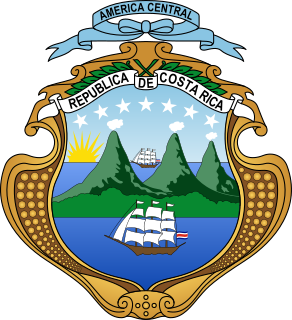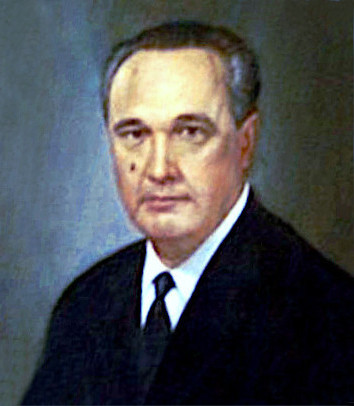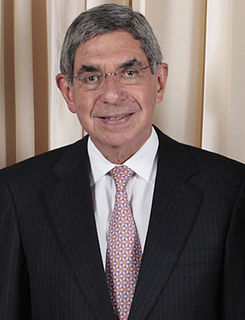
The Costa Rican Renewal Party is a Christian political party in Costa Rica.
The Costa Rican Civil War was the bloodiest event in 20th-century Costa Rican history. It lasted for 44 days, during which approximately 2,000 people are believed to have died. The conflict was precipitated by the vote of the Costa Rican Legislature, dominated by pro-government representatives, to annul the results of the presidential elections held in February, alleging that the triumph of opposition candidate Otilio Ulate had been achieved by fraud.

General elections were held in Costa Rica on 7 December 1913, the first direct elections since 1844. They were also the first elections to have universal male suffrage, after economic and educational requirements were eliminated. Máximo Fernández Alvarado of the Republican Party won the presidential election, but both he and runner-up Carlos Durán Cartín later resigned and Alfredo González Flores was appointed president by Congress on 8 May 1914. The Republican Party also won the parliamentary election. Voter turnout was 78.0% in the presidential election and 78.6% in the parliamentary election.

General elections were held in Costa Rica on 7 December 1919. Julio Acosta García of the Constitutional Party won the presidential election, whilst the party also won the parliamentary election, in which they received 74.9% of the vote. Voter turnout was 57.8% in the presidential election and 42.1% in the parliamentary election.

General elections were held in Costa Rica on 2 December 1923. Ricardo Jiménez Oreamuno of the Republican Party won the presidential election, whilst the party also won the parliamentary election, in which they received 51.5% of the vote. Voter turnout was 70.5% in the presidential election and 83.9% in the parliamentary election.

General elections were held in Costa Rica on 12 February 1928. Cleto González Víquez of the National Union won the presidential election, whilst the party also won the parliamentary election, in which they received 53.3% of the vote. Voter turnout was 62.5% in the presidential election and 72.85% in the parliamentary election.

General elections were held in Costa Rica on 14 February 1932. Ricardo Jiménez Oreamuno of the Independent National Republican Party won the presidential election, whilst the party also won the parliamentary election, in which they received 46.7% of the vote. Voter turnout was 64.2%.

General elections were held in Costa Rica on 11 February 1940. Rafael Ángel Calderón Guardia of the Independent National Republican Party won the presidential election. Voter turnout was 80.8% in the presidential election and 65.6% in the parliamentary election.

General elections were held in Costa Rica on 13 February 1944. Teodoro Picado Michalski of the Victory Bloc won the presidential election with 75.1% of the vote. Voter turnout was 43.2%.

General elections were held in Costa Rica on 8 February 1948. Otilio Ulate Blanco of the National Union Party won the presidential election with 55.3% of the vote, although the elections were deemed fraudulent and annulled by Congress, leading to the Costa Rican Civil War later that year. Following the war, the results of the parliamentary election were also annulled. Voter turnout was 43.8% in the vice-presidential election and 49.2%.

General elections were held in Costa Rica on 6 February 1966. José Joaquín Trejos Fernández of the National Unification Party won the presidential election, whilst the National Liberation Party won the parliamentary election. Voter turnout was 81.4%.

General elections were held in Costa Rica on 1 February 1970. José Figueres Ferrer of the National Liberation Party won the presidential election, whilst his party also won the parliamentary election. Voter turnout was 83.3%.

General elections were held in Costa Rica on 3 February 1974. Daniel Oduber Quirós of the National Liberation Party won the presidential election, whilst his party also won the parliamentary election. Voter turnout was 79.9%.

General elections were held in Costa Rica on 2 February 1986. Óscar Arias of the National Liberation Party won the presidential election, whilst his party also won the parliamentary election. Voter turnout was 81.8%.

Costa Rica held parliamentary and presidential elections on Sunday, 2 February 2014 to elect a new president, two vice presidents, and 57 Legislative Assembly lawmakers. Voting is compulsory in Costa Rica, nevertheless abstentionism was 35 percent in 2006 and 32 percent in 2010. In accordance with Article 132 of the Constitution, the incumbent President, Laura Chinchilla Miranda, was ineligible to run for a second consecutive term.
It is known as "Costa Rican nationalism" the nationalist vision of the cultural and national identity of Costa Rica. According to scholars such as Tatiana Lobo, Carmen Murillo and Giovanna Giglioli, Costa Rican nationalism is based on two main myths; rural democracy since colonial times and the racial (white) "purity" of the Central Valley as the cradle of Costa Rican society.
The 1910 Costa Rican general election was held during the presidency of Cleto González Víquez. This was the last time that indirect elections were held in Costa Rica as for the next one in 1913 the direct vote was implemented. Liberal lawyer Ricardo Jiménez Oreamuno was elected for the first time. Jiménez was very popular in part because of his struggles against the United Fruit Company's abusive operations in the country. Jiménez was proclaimed candidate in the Teatro Variedades during the first Republican National Convention, Costa Rica's first primary election. Jiménez won easily over the other candidate, former president Rafael Yglesias who ruled an authoritarian, though short-lived, regime.
The National Party of Costa Rica was a political party formed by liberal groups for the mid-term legislative elections of 1892, which allied with the supporters of the government of President José Rodríguez Zeledón to defeat the Catholic Union; however, a few months later the governor dissolved the Congress. It was an eminently personalist group, with a diffuse liberal ideology. Si bien Yglesias había pedido que se votara por Echandi pues adujo encontrarse cansado.

Liberalism in Costa Rica is a political philosophy with a long and complex history. Liberals were the hegemonic political group for most of Costa Rica’s history specially during the periods of the Free State and the First Republic, however, as the liberal model exhausted itself and new more left-wing reformist movements clashed during the Costa Rican Civil War liberalism was relegated to a secondary role after the Second Costa Rican Republic with the development of Costa Rica’s Welfare State and its two-party system controlled by social-democratic and Christian democratic parties.

The Reform State or Reformist State is a period in Costa Rican history characterized by the change in political and economic paradigm switching from the uncontrolled capitalism and laissez faire of the Liberal State into a more economically progressive Welfare State. The period ranges from approximately 1940 starting with the presidency of social reformer Rafael Angel Calderón Guardia and ends around the 1980s with the first neoliberal and Washington Consensus reforms that begun after the government of Luis Alberto Monge.














